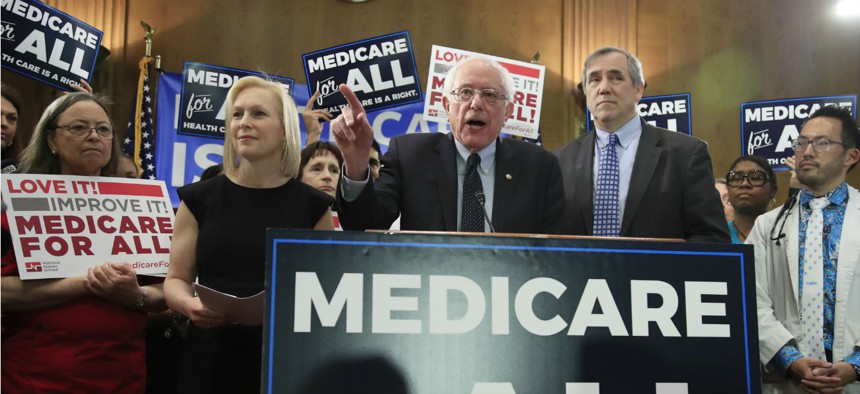Behind Medicare for All: The Sleeper Issue No One Is Debating
If Medicare is expanded to cover all Americans, someone will have to do the back-office work the insurance companies now perform.
For many would-be voters, perhaps the biggest attraction to the concept of “Medicare for All” is the prospect of ending private insurance. Surveys show that while Americans like their doctors, they sure don’t like the insurance companies they have to deal with.
That’s understandable. Everyone has a story about a battle with their insurance company, or about a bill they just didn’t understand. At my doctor’s office recently, a patient came to the desk and the receptionist told him there was a balance due on the account—13 cents. That thrilled his wife, who took the opportunity to empty the pennies out of her purse. On the darker side, though, it’s the insurance company that, most often, puts the breaks on the care a patient receives. Someone has to, since we’d go broke (even faster) on health care if everyone got everything they wanted. But that puts the insurance companies on everyone’s least-favorite-player list in health care.
So imagine how it might work if we were to decide to federalize all private insurance. After all, surveys show that three-fourths of Americans like Medicare, and more than 60% of those surveyed want to steer clear of making major changes in the program. That makes it reasonable to think that Americans would want Medicare for All to be managed the way Medicare for those over 65 is now managed.
That, however, sets up an inescapable choice. To make Medicare for All work—indeed, to make any fundamental change in health care—we will either have to dramatically increase the size of the federal bureaucracy, or we will have to transform the insurance companies into a new role.
At the core of this choice is a basic fact: the federal government now funds Medicare (and its related programs, Medicaid and Children’s Health Insurance), but it does so with a remarkably tiny staff. These three programs account for one-fourth of all federal spending. The bureaucracy that manages them, the Centers for Medicare and Medicaid Services (CMS), part of the Health and Human Services Department, has fewer than 5,000 employees. That’s 25% of federal spending leveraged by 0.2% of all federal workers.
How does CMS work this Medicare magic? The secret sauce in Medicare is the enormous but mostly hidden role of private insurance companies. When a Medicare recipient goes to a health care provider, there is a team member in the back office who sorts out the charges and sends them off to a health insurance intermediary—a “Medicare Administrative Contractor”—that reviews the payments, bills CMS, and passes the payments back to the provider. These are companies most people have never heard of—companies like WPS and Noridian and Novitas—that are responsible for different areas of the country. It’s a vast, complex, and hidden private bureaucracy that makes the public program work. And it’s how CMS can manage such huge programs with such a tiny staff.
If Medicare is expanded to cover all Americans, someone will have to do the back-office work that the insurance companies now perform—figuring out who is eligible for which treatments, how much those treatments ought to cost, and how to transfer the money from the federal treasury to health care providers. There are now almost half a million people in the United States who do that now in private health insurance companies.
Will Medicare for All wipe out private insurance companies? If so, then that work would have to be done by government. That would mean creating a mega-bureaucracy almost as large as the Department of Defense, one that would increase the size of the federal government by 25%. It’s a pretty safe bet that there would be enormous political opposition to creating such a big federal role. That’s been the case for generations, since Harry Truman proposed a similar plan in 1945. When Lyndon B. Johnson won passage of Medicare in 1965, it was part of a deal to avoid creating a big federal bureaucracy, to tamp down some of the fears about “socialized medicine.” The system of public payments through private intermediaries was the result.
Maybe the passage of a Medicare for All plan would mean that the politics had changed enough to allow the creation of a super-department in the federal government. But it’s just as likely that creating the program might be all that supporters could manage. Establishing a mega-agency might be too much, and that would mean running Medicare for All like the current Medicare for the elderly.
In that case, the federal government would face the challenge of leveraging one-sixth of the entire economy through tiny CMS. The complications of running such an operation put Medicare on the Government Accountability Office’s high-risk list (the federal programs most prone to fraud, waste, abuse, and mismanagement) in 1990—and it has remained there ever since. That would be a very, very hard thing.
Now, let’s add one more administrative wrinkle. Even if Congress creates a Medicare for All program, managed like the current Medicare program, there will be irresistible pressure to allow citizens to top-off their coverage with private plans if they so choose. After all, that’s the case now for Medicare, and in both Canada and the United Kingdom, for example, citizens can buy private plans to supplement government coverage.
The United States has a rich tradition of allowing citizens to buy their way to the front of the line. Consider airport security, where $85 will get a traveler five-year access to TSA’s PreCheck, with (often) shorter lines and no need to remove one’s shoes. For $179 a year, a traveler can use CLEAR to jump to the head of the PreCheck line, without even having to dig out an ID.
So, no matter what, private insurance companies aren’t likely to go away. A safe bet is that we’d end up with a public-private system—something like the current hybrid, on steroids.
That, in turn, will mean that private companies would have a lot of power over big issues in the public program. Who would be eligible for which services? How much should providers be paid for these services? Those decisions are shared now between government and the private insurance companies, and that can’t change if a tiny 5,000-person agency remains in charge of Medicare.
This is the sleeper issue at the core of the Medicare for All debate. Just how will the crucial connective tissue work to iron out the big decisions about who pays (government or companies or individuals) and who delivers (private providers, if more than 50 years of Medicare’s history is any guide).
This sleeper issue has received almost no attention in the debate over the future of healthcare. If Medicare’s experience is any guide, that’s where the biggest and most fundamental questions about Medicare for All would be sorted out. As the launch of Obamacare painfully makes clear, those are questions best tackled before launch, so they don’t become big flash points later.
Donald F. Kettl is Sid Richardson Professor at the LBJ School, University of Texas at Austin, and author of the forthcoming book, The Divided States of America (Princeton University Press).




